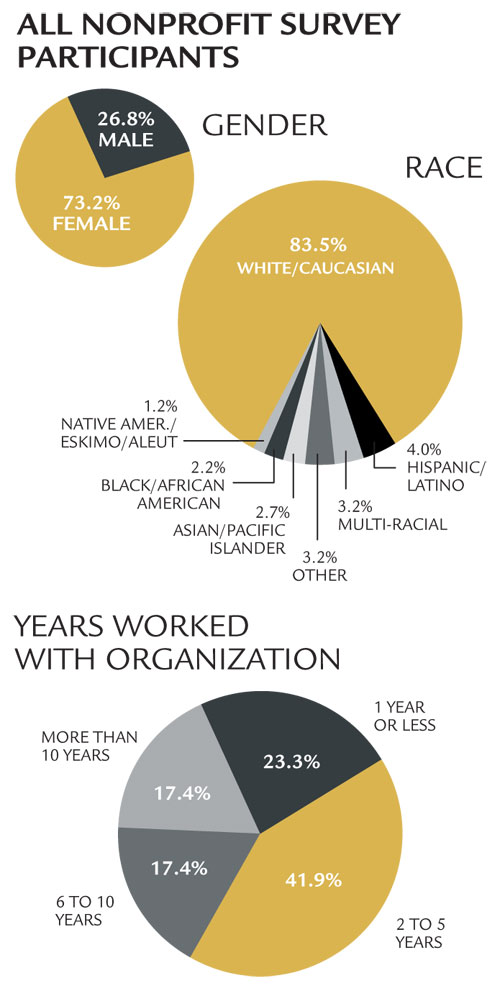Two important themes emerged in a comparison of the inaugural 100 Best Nonprofits survey and those from the 100 Best Company survey: The two groups of employees are very similar in the importance they place on what makes a great workplace, but their satisfaction levels with several key issues are very different.
BY ADAM DAVIS AND SU MIDGHALL
 Two important themes emerged in a comparison of the inaugural 100 Best Nonprofits survey and those from the 100 Best Company survey: The two groups of employees are very similar in the importance they place on what makes a great workplace, but their satisfaction levels with several key issues are very different.
Two important themes emerged in a comparison of the inaugural 100 Best Nonprofits survey and those from the 100 Best Company survey: The two groups of employees are very similar in the importance they place on what makes a great workplace, but their satisfaction levels with several key issues are very different.
The 6,700 employees who participated in the 100 Best Nonprofits survey and the workers who participated in this year’s 100 Best Companies survey all ranked satisfaction and importance of 50 workplace qualities in six categories: benefits and compensation; work environment; decision-making and trust; performance management; and career development and learning. (Ten questions on sustainable practices were surveyed but not used to rank Nonprofits or Companies. The responses to those questions are used to rank the 100 Best Green Companies.) Because many of the same questions were asked in the two surveys, responses were easily compared among employees of these two business sectors.
Employees in the Nonprofits and Companies surveys reported virtually no differences in what workplace qualities were important to them, with the exception of two questions. Nonprofit employees’ rated slightly higher the importance of “fairness for differing racial, gender, sexual-orientation, or disability groups” and of the “organization’s broader support for the community.”
These were not major differences, but were the most noticeable among all of the workplace qualities. As one employee noted about his nonprofit employer: “The management team is great and is made up of both men and women. Women are held in equal esteem as men. The board is equally balanced between men and women.”
As a whole, employees in the nonprofit survey assigned their highest importance ratings to two workplace variables: “treatment of employees by supervisors,” and “pride and belief in the organization.” The latter item clearly reflects the mission-driven quality of nonprofit organizations and their employees, while the former speaks for itself. Nonprofit employees assessed all workplace characteristics to be of relatively high importance.
While importance ratings were highly consistent in this survey and differences between both groups of employees on areas of importance were quite small, there was a much bigger difference between the groups with the satisfaction ratings of the 50 workplace qualities.
Nonprofit employees were most satisfied with having “clear understanding of the organization’s mission and purpose,” “fairness for differing racial, gender, sexual-orientation, or disability groups,” and “pride and belief in the organization.” As noted earlier, the latter was also one of the most important aspects for employees. One employee commented, “There is a sense of family and pride in the work that we do, we work hard and have a fun time doing it.”
 By contrast, nonprofit employees rated their least satisfaction with “opportunities for increases in pay and benefits,” “rewards for top performance,” and “timely discipline and termination of poor performers.” The lowest satisfaction ratings were around compensation structures, but it’s important to note that nonprofit employees were making a distinction between opportunities for financial growth and learning versus their actual compensation.
By contrast, nonprofit employees rated their least satisfaction with “opportunities for increases in pay and benefits,” “rewards for top performance,” and “timely discipline and termination of poor performers.” The lowest satisfaction ratings were around compensation structures, but it’s important to note that nonprofit employees were making a distinction between opportunities for financial growth and learning versus their actual compensation.
Many of the largest differences between employees in the 100 Best Nonprofits survey and those in the 100 Best Companies survey were in career development and learning, not benefits and compensation. While many nonprofit employees saw career development and learning (including opportunities for increases in pay based on performance) as an area in which their employers can improve, employees in this sector demonstrate strong mission-driven dedication to the organizations in which they are employed.
These employees value, and feel they experience the benefits of, a flexible work environment that allows for the balancing of work and family life, which promotes fairness toward workers from all groups, advances a commitment to the betterment of the community, and promotes sustainable practices.
Through the results of this survey employees are telling a story to their nonprofit employers that they want more dialogue about how best to retain their highly qualified staff. This includes opportunities for pay increases, performance-based promotions and rewards, acknowledgment by management for performance, and the organization’s commitment to general career and salary advancements.
Adam Davis and Su Midghall are principals at Davis, Hibbitts and Midghall, a Portland-based research firm. DHM is the research partner with Oregon Business in the 100 Best projects.



